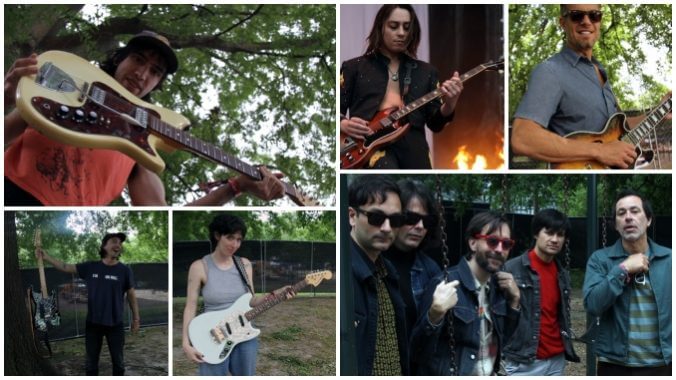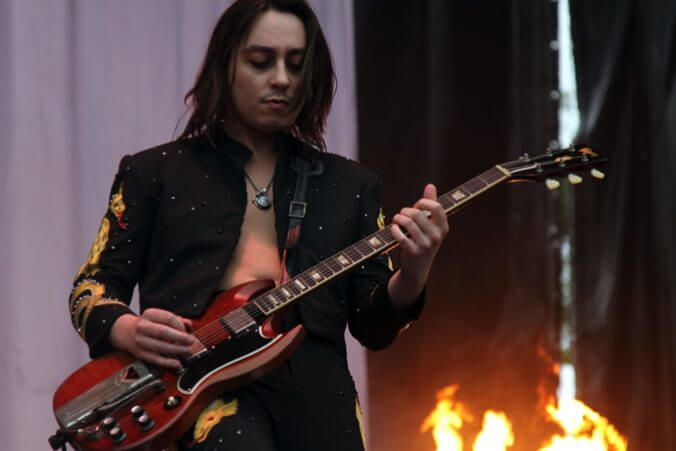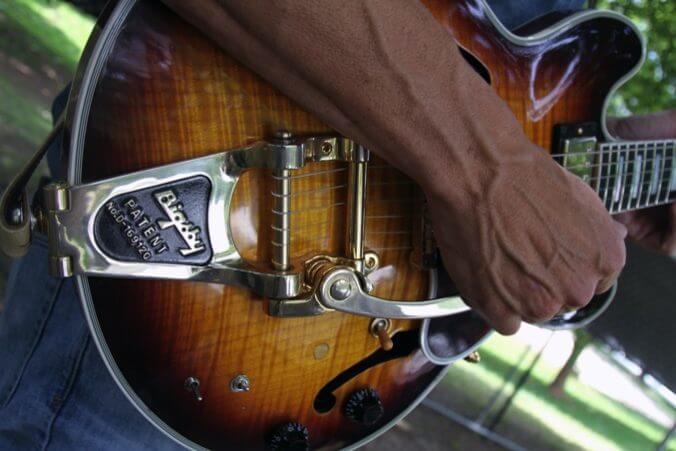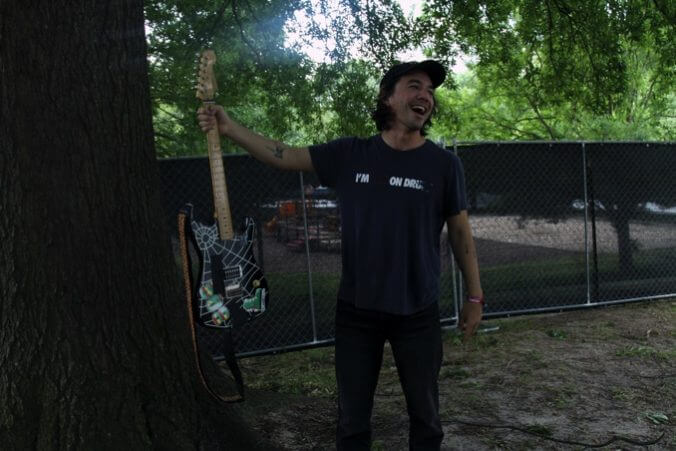For the Love of Guitars: 18 Guitarists on the Instruments They Play
Photos by Michael Dunaway and Johnny Dunaway
For this year’s Shaky Knees, father/son team Michael and Johnny Dunaway set out to photograph, and hear the stories of, the coolest guitars at the fest. The results were fascinating. From a Costco-bought road warrior to an axe custom designed by the top folks at Gibson, and everything in between, here are the photos and stories of the guitars of Shaky Knees 2023.
Greta Van Fleet

Jake Kiszka: “I mainly play a 1961 Les Paul, which is sort of the SG body shape. There’s a story about that guitar. Gibson was making that new body style and calling it a Les Paul, but Les Paul didn’t know they were doing it and told them to take his name off of it. So they did, for three years. And it’s not an inexpensive guitar.
“I got mine six or seven years ago; we had just come out of Michigan and we were touring. We’d stopped by the Chicago Music Exchange. The owner met us there and showed us around. We took a few guitars down to his apartment down the street. I had grown up playing SGs, so I was really drawn to this guitar. We plugged it in at his apartment and the sound just exploded. I had never heard anything like it. At that age, and coming from where we had come from, there just aren’t a lot of resources, and I had just never heard anything like it before in my entire life. And he was sort of convinced that that guitar should go on the road with me, and he said, “You know what? Go ahead and take it. Just pay me when you can afford it.” So he let this kid take this $20,000 guitar out the door, to take it on the road, right off the bat. And I’ve travelled with it ever since. It was a seminal moment. That guitar changed my playing. And it’s accompanied me on the journey the whole way.
“People ask about tone all the time, and there’s so much complexity and nuance in it. It’s in the player’s hands, and it’s coming from their heart and their mind, and there’s a sonic thing with the guitars and amps you’re using. It’s a combination of all that stuff, where that sound comes from. I can’t explain it—it’s something that just has to be felt.”
311

Tim Mahoney: “This guitar that I brought was probably made in 1996 or 1997. Our whole career I’ve played Paul Reed Smith guitars. That’s a Paul Reed Smith Custom 24. It was a gift from them when we were working on Transitions. I’ve been using that thing ever since then. I tend to use one guitar the whole show unless a song has a different tuning. It’s a natural mahogany with a rosewood top. It handles the clean and the high gain really well. And it’s fun to play. I’ve been using their guitars for more than 30 years now. I do love other guitars, but for what we’re doing up there during the course of the set, it handles it all.”
Nick Hexum:
“I’m a Gibson guy. Growing up, my heroes were Jimmy Page and Mick Jones of The Clash, and I got really into Les Pauls. My first Gibson, I went on a camping trip with my Dad in Banff, Canada, and found what I thought was a 1963 Les Paul Goldtop. I played that for a long time, and then somebody broke the neck, and I sold it and was really disappointed. Years later, I was talking to the president of Gibson, and I was telling him about it and told him it had the small pickups, and he told me it couldn’t have been a 1963. So it wasn’t the guitar I thought it was. But I was into Les Pauls for a long time, and then I got into the 335s and 355s, the bigger body style. Lately I’ve been playing the smaller version of the semi-hollow. Today I’m playing a 356, which is like the 355 with the really fancy inlays, but it’s a little smaller. Still a big guitar compared to a Les Paul. To me it’s like a sweet spot. I usually use the neck pickup for a warmer sound, and then I have a sustainer pickup that can give me some kind of otherworldy sounds, that makes the sound swell.”
Olivia Jean
“It’s a Fender Maverick Durado Parallel Universe. It’s fuschia pink with custom sparkles, painted by Chip Ellis, who’s the head of the Fender Custom shop. And then Tim Shaw, who’s the big-time pickup maker, made those pickups himself and installed them himself. So I really got hooked up by the Custom Shop. The pickups make it. Those Tim Shaw pickups are amazing. They’re so bright and they cut through heavy music, but they’re not ear-piercing. The pickups are the secret. I highly recommend them. [Holding the guitar] feels great. The one strange thing is that with the Parallel Universe guitar, they took a 12-string guitar headstock and put in on a six-string body. So it looks like a hockey stick. That was the one thing that was hard to get used to, especially tuning when the keys are so far apart. And banging into things too. But it’s cool! And people love that guitar; it’s a showstopper. [I call it] ‘Holly Grail.’ The last guitar I’ll ever need.”
Gringo Star

Pete Furgiuele: “I play a Rickenbacker. I got it for my 16th birthday. It’s the only guitar I’ve ever had. The switch has kind of malfunctioned, in a way. It cuts the signal. And I’ve had it so long that I use it kind of like a mute. That’s the only real mod. A disintegration mod, haha. The frets are really worn down so that the strings sometimes get caught, but I’m kind of afraid to fix it.”
Josh Longino: “I provide the backup guitar, so I just play a little Squier Jazzmaster that I got for 300 bucks on the internet. It’s good enough to play. It fills the hole. It’s a 2016 and they were still doing the rosewood necks, so the neck’s actually kind of nice. I don’t dig the new Mexi Squiers and Korean Squiers that use all the weird wood on the neck. I grew up playing ebony or rosewood necks, so those just feel right to me.”
Jonathan Bragg: “I have a 1982 Fender Squier Strat. That was the last year they were made in America, before the whole line moved to Japan. It rules. I traded with a guy in a band named Rehab for it. It was his childhood guitar that his parents bought for him. It’s got the big head stock so you can do that Johnny Cash thing. I had almost bought one from one of the guys in Drivin ‘n Cryin, but the neck was all blown out on it and the frets were completely flat. But then I was at that dude’s house and saw it on a corner and bought it.”
Spacey Jane
Ashton Hardman-Le cornu: “I play a Fender, it’s a 1966. I got it for my 18th birthday. I used to live in Canada, and my dad and I went out to some guy’s shack to buy it. I love it, it’s been with me every step of the way. I like it because it sounds really hot, and the action is a bit higher. It’s really worn in, in just the right way.
Caleb Harper: “I have a Rickenbacker 620. The reason that I got it was that I started out as a bass player, and I really liked the Rickenbacker 420 bass. I was obsessed with the shape. I thought if I’m going to play a six-string guitar, I want it to be the same shape body. I’ve been playing it for 14 years. I’ve dinged it quite a bit, because our shows are quite wild, especially early on when we were playing club shows and knocking into shit all the time, and drunk kids on the floor and stuff. The thing I love about it is that I can make it sound any way I want it to. I’ve made a lot of different sounding records with it, which is cool. It feels like a short scale because the neck sits so far up compared to a Strat or something. And now I have a second one that I use as a spare. Just in case I smash the first one onstage.”
Peppa Lane: “When I first started playing bass, I played the heaviest, most difficult bass to play. The head was heavier than the body so it always just dipped. It was 50 dollars, secondhand. It was just what was around, and what we could afford. I’d been playing that bass at Uni for quite awhile. I went out with my parents to find a new bass. I tried a bunch and they were okay, but then I tried a 3/4 Fender Mustang. So many bass players play these basses, and now I see why. It felt like an extension of myself. It just felt like I could play through it. I love a small electric bass. I can jump around!”
Futurebirds
Thomas Johnson: “I play a 2000 Mexican Telecaster. The guy who managed us came with us to Chicago in 2009 or 2010 and there’s this great store called the Chicago Music Exchange. We kind of went just to look at guitars, because we were way too broke to afford anything there. But our manager was like, ‘I think I’m going to buy a guitar.’ And I said. ‘But you don’t play guitar.’ And he said, ‘Yeah, but I feel like I want to buy one.’ So he bought this Telecaster. At the time, I was playing this American Standard, early ’90s Telecaster that our drummer at the time owned. I had been playing that guitar exclusively for about three years. And he left the band and asked for it back. So I said, “Hey, Jay, that Tele you bought in Chicago, mind if I take that on the road?” He said yes, and I don’t think he’s seen it since.
“It’s crazy; it’s not the best version of the Tele. It’s got some weird things. But every time I try to play something else, I end up going back to my main squeeze. I’ve done so much playing on it and writing on it that, for better or worse, I just love the way it sounds. My granddad was somewhat of a guitar collector, and he’s gifted me some great guitars over the years. I have an awesome early ’80s Strat he gave me that’s my backup guitar now, and that guitar is awesome, but it’s still not my go-to. The Tele is like a road dog. You can beat it up and it’s still going to show up every night. That’s valuable. I’ve heard people in sports say sometimes the best ability is availability. It might not sound as pretty as everything else, but I know how to play it and that’s my baby now. We’re kindred spirits.
“But also, we’re playing at the Ryman in a couple of weeks. I’ve never even been there. And my grandfather has a 1955 Les Paul that he financed in 1956 for $40 down, $235 total. He’s coming to the show, and he wants to see me play it onstage at the Ryman. I’m not worthy! But I’m really excited.”
Daisy the Great

Nardo Ochoa: “I’m holding a Kappa Continental. It’s kind of an unusual story because I had just played my roommate’s Jazzmaster and I was thinking, ‘I need a guitar like this.’ I was opening up for Delicate Steve and he recommended me to a guy who’s now a friend of mine, Ofir Gannon. He’s an incredible player, but his hobby is finding rare guitars and sprucing them up. I went to his house and played it and thought, there’s no way I can buy this. It’s so unique and the playability is so tough. But I went home and thought about it and came back and bought it. It really sounds unlike anything I’ve ever played before. And it’s taught me so much about the instrument.
Matt Lau: “My guitar is a Tele offset, so it’s a Telecaster in a Jazzmaster body. I always played bass, and this was the first six-string I bought when my friends needed someone to play guitar in their band. People always come up and ask about it, because it looks weird. The bridge pickup is basically unusable because it’s so bright, although that can be fun sometimes. But I mostly use it on the neck pickup, which is kind of unusual for Telecaster players, I think. It was in a flood at Nardo’s house and the neck cracked, but I don’t know, I feel like it just makes it play better.
Mina Walker: “I have a Thunder Mustang American Performer series. I like because it’s matte, not shiny. It’s electric blue, so it’s almost white. With a flash it actually looks white. It has a pearl pickguard. It’s very pretty, and very sparkly sounding. My first guitar was an Epiphone that had a very warm, full sound, but getting the Mustang made me feel like I could shred. It’s really fun to play, very smooth. It doesn’t have a fixed bridge, so it really stays in tune really well if you don’t change the tuning, but if you do, all the strings go out of whack. But it’s worth it because the whammy bridge is really cool.
Aquadolls
Melissa Brooks: “I have a few guitars. I got my first electric guitar when I was a senior in high school and I chose it solely based on wanting a tan guitar so that I could draw boobs on the back and flip it up to show them. And it happened to be a Danelectro that my friend found on Craigslist for like $200. And I played it for a few years and then decided I wanted a Danelectro that was blue with glitter. So I chose that guitar not because of tone, not because of performance, but purely because of how it looks. So I got into Danelectro kind of by accident, but it produces this kind of plastic-y, twangy tone that’s become the signature sound of the band.”
Cafune
Sedona Schat: “Noah actually found my guitar for me, because he has something we refer to as GAS [Gear Acquisition Syndrome]. For years I kinda struggled in our shows with finding the right guitar sound. The [2011 or 2012 Mexican] Jazzmaster feels like I’ve finally found the right guitar for playing onstage. It’s got a nice body, and it’s flexible because you can switch between the top and the bottom. It’s really comfortable, and a nice size. Everything about it is just right. I used to play a Strat with lipstick pickups, and it was really fun, but it was maybe a little too jangly. And then I found this 1957 Musicmaster, which was also really amazing, but was a little too small and didn’t really have the body that the Jazzmaster has. I’m really stoked that Noah found the Jazzmaster for me, because it’s definitely my favorite guitar I’ve ever played.”
Noah Yoo: “My guitar is actually a Squier. It’s a Paranormal Offset Telecaster. I really like Jazzmasters, but I couldn’t justify buying another one. But I found this guitar and loved it. It’s the first guitar I’ve been comfortable making changes to. So I put in some Lawler pickups, put some stickers on it, because obviously that affects the sound the most. I have a sticker of Courage the Cowardly Dog, just kinda hanging out on the back of the guitar where no one can see him but me. I’m always having a better day than Courage.”
FIDLAR

Zac Carper: I went to my guitar dude and I wanted a really light guitar. It has only one knob. It’s very easy. And he was like, ‘No dude, you do not want that guitar, I’ve had that guitar for 15 years and nobody’s wanted to buy it. You can just have it.’ And about a year later he sends me a link and says, ‘I think I’ve figured out where that guitar came from.’ Dude, this guitar is from Costco, in Ottawa. Some dude was making guitars in Canada and sourcing them out to Ottawa. And I’ve been playing it ever since I bought it. My whole kind of thing about a guitar is that it’s a tool. I don’t really have precious sentiment about guitars. I have really good gear, but playing live, our fans don’t care if a guitar sounds vintage or anything else. They just want it loud. And this is the loudest guitar! Every time I’ve brought it into every session, people say it’s the loudest guitar they’ve ever recorded. I don’t know why; I think maybe it’s the way the pickups are wound? But if you plug it into an amp, it’s instant feedback. I throw this thing around. If it gets lost on the airplane, I mean it was 80 bucks at Costco.”







































